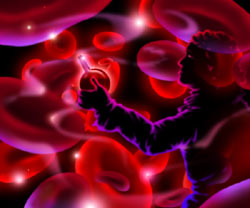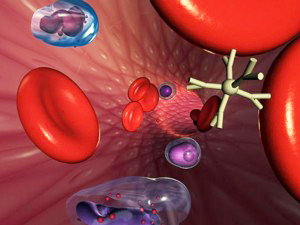|
Here we recount the tale of the origins of
blood transfusions as told in the story of Antoine Mauroy one of
the first people to receive one.
by Pete Moore
And so we arrive back at the night
of December 19, 1667 in Henri de Montmor’s library. To the
pleasure of some and the extreme consternation of others, the two
physicians, Jean-Baptiste Denis and Paul Emmerey, announced that
as far as they could see, Antoine Mauroy their prospective patient
was stable and in good basic health. He was a perfect candidate
for their revolutionary therapy. Yes, he would be the next patient
to receive some transfused blood. To avoid any possible deterioration,
the operation should be carried out at the earliest possible time.
This, they stated was a trial of an idea. They weren’t about
to look too confident in claiming any sense of certainty that the
procedure would cure the poor man’s condition, though they
certainly hoped to perform a wonder. Looking cautious and then claiming
stunning success in a few days time was their preferred course of
action.
Their hesitation was justified on practical
grounds. They had never performed the operation on someone who was
physically well, but had deranged behaviour. Their best guess was
that they should use blood from a calf as “its mildness and
strengths might possibly allay the heat and ebullition of his blood”.
A time was set for the operation – six o’clock that
evening, and with much fuss and elaborate bowing the assembly dissipated.

Image Courtesy Wellyn
Blakeslee
The artist
behind this rather striking image describes this as representing
the dawning of true blood science, in times when the currency
of life was still widely, warily viewed as an opaque mystery.
The figure, purposefully vague, might be interpreted as
one of any number of the doctors and/or natural philosophers
of such times.
|
Soon the room was empty save for the
two scientists, their host and patron Montmor and the unfortunate
Mauroy. His continued presence was less than voluntary as he was
still tied to his chair, and had once again started to complain
bitterly and vocally. As usual, Montmor was in charge. He summoned
a troupe of servants and began to make arrangements to have the
‘patient’ transferred to another house, the thought
of listening to his shouting for the rest of the day was just too
much to be contemplated. Besides, his residence was in a fashionable
part of Paris, and Montmor had no intention of bringing bad repute
to his name and his house by having the neighbours making accusations
that a riot was about to break out.
It is most likely that as Montmor and
Denis planned the rest of the day’s details, discussing where
they would obtain a suitable blood donor and agreeing the level
of fees involved for all the participants, they saw this as their
opportunity to stun the world and gain entry to the newly formed
Académie. Becoming the first people in the world to cure
mental illness would certainly do their applications for membership
no harm at all.
Recording the events that followed
in a letter sent initially to Montmor, a copy of which then went
to Oldenburg in London, Denis said that they transported Mauroy
to a “private house”, most probably Denis’ residence
on the Quay des Augustins. Montmor and Denis also sent for a burley
labourer to act as their ‘porter’. They needed to contain
Mauroy, but Denis also wanted to reassure him. Working with calm
patients is always easier, and more likely to bring about good outcomes.
Who better to employ as this guardian-cum-gaoler than someone who
had personally benefited from transfusion? Their choice was no muscle-man
picked at random, but the man into whom Denis had transfused lamb’s
blood eight months earlier; the man who Denis claimed had been so
eager to receive a second dose.

Copyright 1999, Daniel Higgins, University of Illinois at
Chicago.
This image
depicts the future of blood science, where tiny capsules
much smaller than these blood cells may someday be injected
into people's bloodstreams to treat conditions ranging from
cancer to radiation damage.
|
Throughout the day a stream of people
started to arrive, and Denis was pleased that among them are both
physicians and churchgoers. Acting as witnesses this means that
he would have people who understood what he was doing, as well as
members of the public who were held in good repute. As the evening
came, so too did the two scientists and a calf. In Oldenburg’s
translation of Denis words, “We used what art we could to
dispose the fancy of our patient to suffer the transfusion”.
It is a nice turn of phrase that can quite probably be translated
as “we strapped and bound the patient firmly to a solid table
in the middle of the room”. He might even have been gagged
to lessen his wails of protest.
Denis and Emmerey were determined not
to run out of blood half way though the trial so a calf was a good
choice as it would be fairly large. It would also be relatively
docile. Even so, it is a fair assumption that the calf in this particular
episode would have been securely tied to a table, in such a way
that it was incapable of moving.
Conversation dimmed to a dull murmur
as, working under the light of several lanterns, Emmerey cut into
the inner thigh of the calf’s leg and revealed a bulging crimson
artery. The spectators jostled gently for position, each wanting
to get close, but at the same time anxious to keep out of the line
of fire because, with the possible exception of Mauroy, everyone
in the room was well aware that a minor slip of Emmerey’s
knife would send a pulsing fountain of blood half way across the
room. Observing science is interesting, but more important still,
they had their clothes to think of.
This image
depicts myoglobin. Along with hemoglobin the primary oxygen
storage and transport proteins in all higher animals including
humans. It is important for medical reasons because they
are primary blood proteins.
|
With the calf vessel exposed and ready
to deliver its elixir, it was time to turn to the patient. Standing
over him, Emmerey cut into his right arm and revealed a vein just
above the elbow joint. His work was hampered by the patient’s
struggles and by the time that the incision was finished Mauroy
had managed to curl himself into something resembling a fetal position,
a primate act of self-protection. His arm was, however, still tied
firmly to a table leg and the incision and vein were neatly exposed.
Following instruction, the tables bearing
the calf and Mauroy were brought close together ready for the transfusion.
But first, Emmerey wanted to make room in the patient’s body
for the influx of blood. This meant that some needed to be let out
first. He snicked the exposed vein and watched while blood streamed
into a bowl. He waited until Denis calculated that some 10 ounces
of blood had escaped and then inserted the end of a hollow quill
into the vein. Quickly he cut the calf’s artery, pushed a
second quill into it and watched blood spurt out of the end. With
surprising dexterity he and Denis joined these two together with
a series of quills, forming a complete pipe. Emmerey was excited
and stretched out his fingers to relieve tension – things
were going well.
Denis started counting, planning on
judging the time that would be needed to let in 10 ounces of blood
and replace the full volume lost in the enforced haemorrhage. It
was soon clear, though, that all was not going smoothly. In their
enthusiasm to witness the event, the spectators surged forward to
get a better view. For a few moments it was impossible for either
Emmerey or Denis to get near to their patient. Etiquette also made
it difficult for these experts who came from the middle ranks of
society to order their superiors back, but necessity called and
they elbowed their way back to the centre of proceedings.
Blood collection
kit for
Space Lab 1
|
Mauroy’s struggles meant that
he was no longer lying in a convenient position and the blood was
not flowing through the tube. By the time that the two technicians
had got back to their charge this lack of flow had allowed the blood
to congeal in the tubes so that it was no longer transfusing from
calf to human. The occasional plume of blood shot across the room
while they frantically tried to change to new quills, and attempted
to restore some of the flow.
By now the patient was complaining
that his arm was feeling very hot, right up under his armpit. “Perceiving
that he was falling into a swoon we presently stopped the blood
running in, and closed up the wound”, comments Denis. The
transfusion was over and Denis calculated that Mauroy had received
something in the order of five or six ounces.
Denis was relieved. The transfusion
had worked, but now the critical part was to keep a close watch
on the patient to see what happened next. Some of the guests decided
this was the time to move on and seek more lively entertainment
elsewhere for the rest of the evening. Others took seats and waited,
staring at the man as if they wondered whether he was about to bellow
like a calf or grow horns or hooves.
Now check out our
Fact File Section for
Twenty
Facts about Blood.
|
